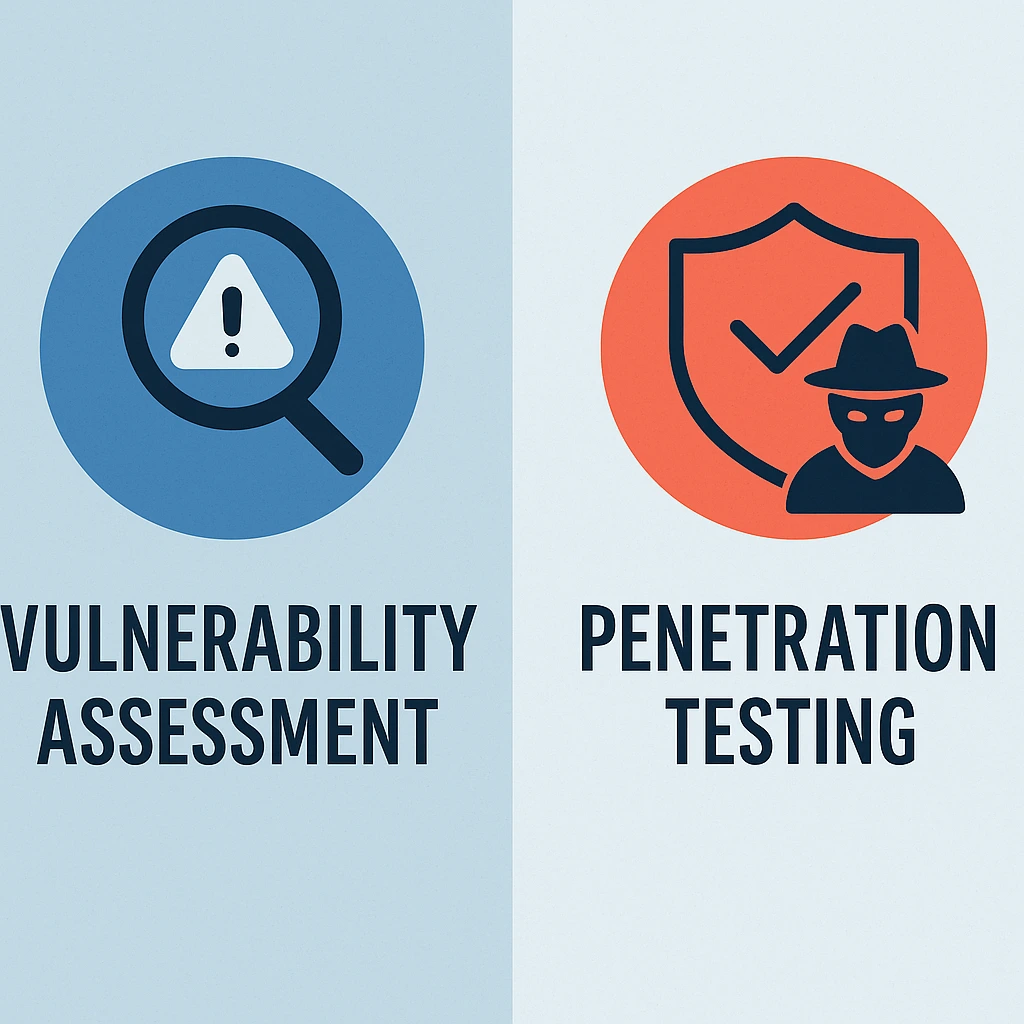
Vulnerability assessments and penetration tests deliver distinct, actionable insights that help security teams tighten defenses and meet compliance.
A vulnerability assessment inventories assets, scans for known weaknesses, and prioritizes findings by risk, typically producing a risk score, vulnerability details, affected components, and remediation guidance. It answers: what is exposed, where, and how severe the exposure is.
In contrast, a penetration test simulates a real attacker's lifecycle, attempting exploitation to reveal exploitable paths, containment gaps, and practical impact. It delivers validated breach scenarios, evidence of how far an attacker could move, and prioritized remediation with exploit chains, evidence artifacts, and targeted risk reduction.
Combined, these services provide a comprehensive security picture: the vulnerability assessment offers broad visibility and trend analysis across the environment; the penetration test confirms whether identified weaknesses can actually be exploited and demonstrates the resilience of security controls.
For organizations selecting the right approach, consider risk tolerance, compliance requirements, and resources. If you need fast, high-coverage discovery and ongoing monitoring, start with a vulnerability assessment and remediation backlog. If leadership requires assurance through tested exploitation and real-world impact, schedule a scoped penetration test, with clear scope, rules, and deliverables. This structured approach aligns risk, budget, and timelines effectively.
Vulnerability assessment and penetration testing are two cornerstone security processes, but they serve different purposes and expectations.
A vulnerability assessment inventories known weaknesses across an environment, prioritizing findings by risk level and impact. It relies heavily on automated scanners, credentialed access, and broad coverage to create an appetite for remediation rather than proof of exploitability. The result is a comprehensive list of exposed configurations, missing patches, and misconfigurations that attackers could leverage. The process emphasizes speed, repeatability, and scoring trends over time, giving security teams a map of potential gaps without testing whether those gaps can be exploited in practice.
Penetration testing, in contrast, seeks to prove exploitability by mimicking attacker techniques against targeted systems. Skilled testers exploit identified weaknesses, escalate privileges, and extract data in controlled conditions to measure actual risk and impact. The deliverable is evidence-based and narrative, usually highlighting attack chains, containment steps, and remediation priorities grounded in demonstrated risk rather than the theoretical vulnerability.
Pentests are resource-intensive, time-bound, and often authenticated or semi-authenticated to simulate insider or remote breaches. The trade-off is precision and context: fewer findings, but with verified exploit paths and clear guidance for reducing business risk. This balance helps executives allocate resources.
Organizations often face a choice between vulnerability assessment and penetration testing, a choice that shapes risk visibility, remediation velocity, and security posture.
A vulnerability assessment uses automated scans to uncover known weaknesses across systems, network devices, and configurations, delivering a prioritized list of flaws and potential impact. It is fast, repeatable, and cost effective for broad inventory and compliance reporting. However, it can produce false positives and may miss exploitable chains of weaknesses that a real attacker could chain together.
Penetration testing, by contrast, simulates a skilled adversary attempting to breach defenses and access sensitive data. It emphasizes exploit chains, timing, and attacker pathways, revealing realistic risk under realistic conditions.
Because organizations operate in different risk contexts, the right choice depends on objectives, budget, and regulatory demands. A mature security program often blends both: schedule regular vulnerability scans for visibility, followed by targeted penetration tests to validate critical assets and evaluate detection, response, and containment capabilities. Prioritization should align with business impact, asset criticality, and threat modeling; remediation must be tracked, tested, and retested.
By choosing a thoughtful, phased approach, organizations turn assessments into measurable improvements rather than endless alarms. This balanced strategy builds trust with regulators and stakeholders worldwide.
Vulnerability assessments provide a systematic, repeatable view of an organization's security posture by scanning assets, cataloging weaknesses, and prioritizing remediation based on risk. Use cases include ongoing hygiene for large networks, compliance-driven audits, and predeploy checks before major software releases.
Unlike targeted penetration tests, VA focuses on broad coverage and repeatability, making it ideal for measuring progress over time and aligning IT, security, and business teams on risk priorities. Benefits include faster identification of known vulnerabilities, lower remediation costs through early discovery, and the ability to benchmark security maturity after policy changes or environment updates.
When organizations distinguish between vulnerability assessment and penetration testing, they often choose VA for continuous monitoring at scale, routine vulnerability management, and evidence-driven reporting for executives and regulators. Key outcomes are an asset-centric view, actionable risk scores, and a clear remediation roadmap that translates technical findings into business impact.
However, VA should be complemented by selective, risk-based pentesting to validate critical controls, impersonation paths, and real-world exploitability. Together, VA and targeted testing form a layered defense that supports resilient, compliant, and cost-conscious security programs. Regular reviews ensure alignment with evolving threats, regulatory demands, and business objectives for resilience continuously.
Penetration testing helps organizations validate security controls, uncover exploitable gaps, and quantify risk in practical terms. Use cases span external and internal network testing, web and mobile application assessments, API security, cloud configurations, and social engineering simulations that reveal real attacker possibilities.
By contrast with vulnerability assessments, which enumerate known weaknesses, a penetration test demonstrates how those weaknesses could be chained into concrete breaches, data loss, or service disruption. This approach supports risk-based decision making, regulatory preparedness, and leadership buy-in by translating technical findings into business impact. Benefits include prioritized remediation guidance, validated security posture, and improved incident response readiness through realistic attack scenarios.
Penetration testing also informs secure design at the development and procurement stages, reinforces defense in depth, and helps organizations meet compliance requirements for standards that demand tested controls. In practice, practitioners tailor tests to risk profiles, critical assets, and threat models, from phishing simulations to privilege escalation on targeted systems.
When planning, teams distinguish a one-off assessment from ongoing testing programs, ensuring independence, reproducibility, and measurable improvements over time. Selecting the right approach, vulnerability assessment versus penetration test, depends on goals, horizon, budget, and the level of assurance required to protect customers and reputation.